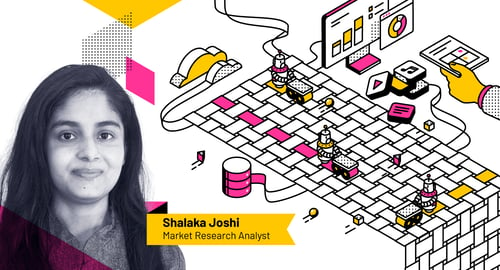This post is part of G2's 2024 technology trends series. Read more about G2’s perspective on digital transformation trends in an introduction from Chris Voce, VP, market research, and additional coverage on trends identified by G2’s analysts.
Data fabric software continues to be essential for data-driven businesses
Prediction
In 2024, data fabric platforms will reduce human intervention in data management processes, with consolidation and automation occurring in this market in the next year and beyond.
G2 expects to see data fabric software continue to bring about consolidation in the data management space by integrating various capabilities such as active metadata management, identifying new data sources for ingestion, and supporting cloud, hybrid cloud, and multi-cloud deployments.
In addition, artificial intelligence (AI) will play a critical role in helping the platform automate real-time insights and data monitoring.
From data to insights: the crucial role of data fabric in the AI era
Data fabric platforms help seamlessly access and share data in a distributed data environment. With several companies realizing the benefits of being “data driven,” it is essential for data to be visible and accessible to concerned internal stakeholders.
In addition, with the emergence of generative AI on the rise, a lot of synthetic data is generated. This data needs to be organized and managed for insightful analysis.
AI generates and consumes large amounts of data; thus, data management becomes critical.
This is where data fabric software steps in.
Data fabric software has introduced AI and machine learning (ML) algorithms with active metadata to help automate the data integration design. Various tools like data preparation have also been consolidated into the data fabric architecture.
G2 data shows growing ROI for data fabric platforms
As part of our analysis, we compared the return on investment (ROI) of several data management categories on G2.
G2 data shows a positive ROI for the last 12 months, where the average month to achieve ROI is three for Data Fabric Software, six for Data Preparation Software and Active Metadata Management Software, and over 12 months for DataOps Platforms.

We infer that end-users observe more benefits from opting for a combined offering rather than needing to purchase each tool separately, ensuring hassle-free data management and ushering in a new era of automation and consolidation.
In the coming years, we expect several vendors to create a unified data fabric platform for data management and automating tasks such as aligning schema to new data sources and profiling data.
Additional features such as active metadata management will help automate data governance, data security, and data engineering tasks and augment data integration.
Using machine learning (ML), data fabric efficiency can be enhanced by observing the functions of data engineers and providing them with the subsequent best actions. ML and graph analysis can help automate new data profiling.
The path ahead for data fabric software
Data fabric software is expected to go “humanless” because of its ability to detect differences between expected and actual data patterns. This will help develop accurate data failure response protocols to work and look after any data problems without human intervention.
Thus, we expect to see data fabric software getting adopted by all business segments alike.
Ultimately, using ML in data fabric platforms will provide traceability, transparency, and provability of metadata analytics, which will help companies in continuous exploratory work, creating more consumer value.
Understand how active metadata allows companies to make improved data-driven decisions with G2’s active metadata management category.
Edited by Shanti S Nair


 by Shalaka Joshi
by Shalaka Joshi
 by Shalaka Joshi
by Shalaka Joshi
 by Shalaka Joshi
by Shalaka Joshi